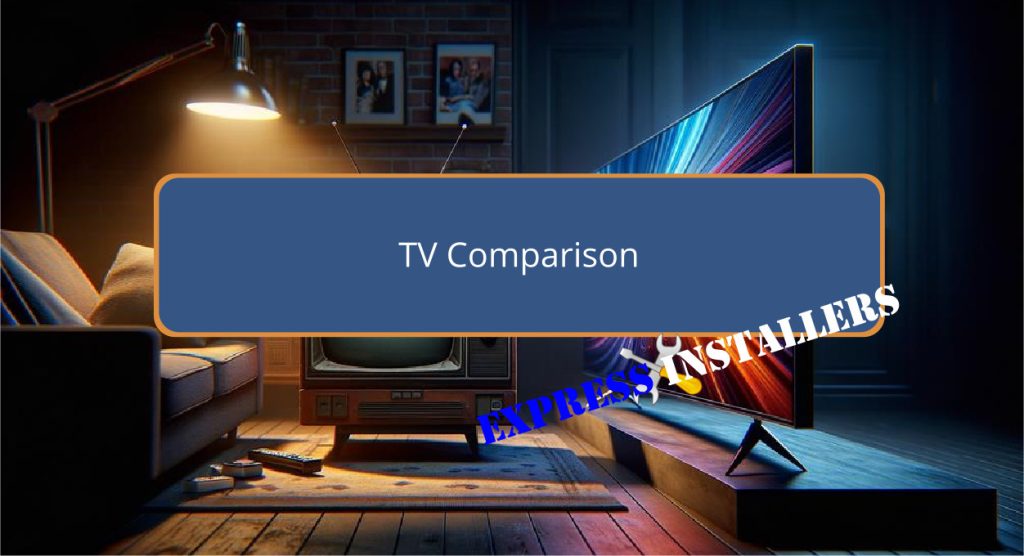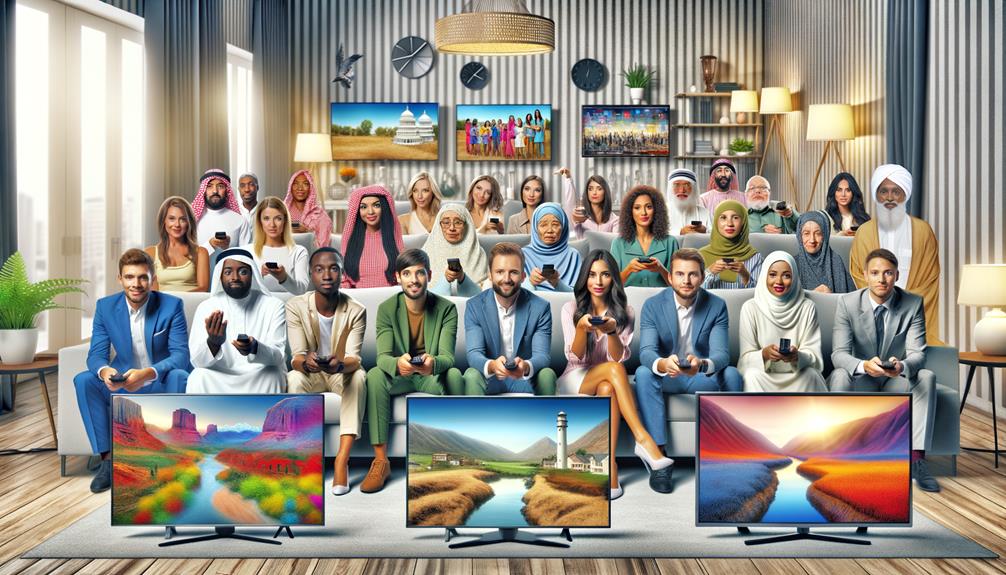
When comparing TVs, it’s important to assess display technologies, screen resolutions, and smart features.
OLED TVs offer superior contrast and colour fidelity, while QLED sets excel in colour accuracy thanks to quantum dots.
Screen resolution ranges from Full HD to 8K, affecting sharpness and detail. Smart TVs vary in connectivity, with options like Chromecast and AirPlay, and integrated voice control.
The choice between brands also plays a significant role, impacting reliability and price, with established brands generally commanding higher costs.
Additionally, considering energy efficiency and audio quality — like Dolby Atmos support — can enhance viewing experiences.
Exploring these aspects will lead to a sophisticated choice of TV.
Get a discount with Express Installers. Express Installers has been installing TVs for over 20 years and has built relationships with major suppliers. We pass the discounts on to you and offer top-notch installation of your new TV.
Don’t just take our word for it; check out our Independent TV Installation Reviews.
Quick Summary
- Compare screen resolutions: Full HD, 4K, and 8K affect sharpness and detail.
- Evaluate display types: OLED, QLED, Mini-LED, and MicroLED offer distinct image quality benefits.
- Assess smart TV features: Chromecast, AirPlay, and voice control enhance user interaction.
- Consider audio technologies: Dolby Atmos and built-in soundbars improve sound quality.
- Get it cheaper with Express Installers and benefit from our high-end Installation service.
Understanding TV Technologies
To comprehend the landscape of modern television technologies, it is essential to explore the distinct features and advances presented by OLED, LED, QLED, and emerging smart TV technologies.
OLED TVs are renowned for their exceptional colour accuracy, with models like the LG C4 OLED delivering vibrant colours alongside profound blacks.
This technology guarantees a more immersive viewing experience by enhancing colour fidelity.
On the other hand, input lag, critical for gaming and real-time applications, is impressively low in OLED and some advanced LED models, such as the Sony BRAVIA 9 QLED.
QLED TVs leverage quantum dots to further boost colour accuracy, making them competitive in markets prioritising high-definition visual output.
Smart TVs integrate these benefits with connectivity features, augmenting user interaction and content accessibility.
Evaluating Screen Resolutions
Screen resolutions, ranging from Full HD to the more advanced 4K and 8K options, greatly influence the sharpness and detail of the display, enhancing the overall viewing experience on modern televisions.
The resolution impact is significant as it directly correlates with visual clarity, ensuring images appear more lifelike and immersive.
| Resolution Type | Pixels |
|---|---|
| Full HD | 1920 x 1080 |
| 4K | 3840 x 2160 |
| 8K | 7680 x 4320 |
| Impact | Enhances sharpness and detail |
| Importance | Improves visual clarity |
Understanding these differences is vital for consumers aiming to optimise their viewing experience, whether for casual viewing or for high-definition content consumption.
Comparing Smart TV Features

Smart TVs today come equipped with a variety of features that enhance user interaction and integration with other devices.
For instance, connectivity options such as Chromecast and AirPlay, found in Hisense 75U7K and Sony Bravia XR-77A95L respectively, streamline content sharing from mobile devices to the TV, facilitating a seamless streaming experience.
Voice control technologies such as Google Assistant and Amazon Alexa, integrated into models like Samsung QN85QN850DF and LG OLED83G3PUA, allow for hands-free operation and smart home management.
This enhances user convenience by enabling voice commands for controlling TV functions and connected devices.
Additionally, the broad app availability on these platforms ensures that users have access to a plethora of streaming services, significantly enriching the entertainment experience.
Analysing Display Types
Display technology greatly influences the visual quality of televisions, with each type offering distinct advantages for image clarity and colour precision.
- OLED TVs: Known for their superior contrast ratios, OLED displays deliver deeper blacks by allowing individual pixels to turn off completely. This feature enhances the overall picture quality with stark contrasts especially in dark scenes.
- QLED TVs: These utilise quantum dots to markedly boost colour accuracy and brightness levels, providing a more vibrant and immersive viewing experience.
- Mini-LED TVs: Improved local dimming capabilities due to numerous small LEDs allow for better differentiation between light and dark areas, enhancing HDR performance.
- MicroLED TVs: They excel in brightness and color accuracy, with the added benefit of longevity, making them a durable choice in the high-end market segment.
Assessing Audio Quality

Audio quality in televisions is crucial for an immersive viewing experience. The performance varies based on the model and technological enhancements.
Modern TVs often include advanced audio features like Dolby Atmos, which creates a three-dimensional auditory space, greatly enhancing sound quality.
Some models have built-in sound bars or are compatible with high-end external audio systems, boosting the acoustic output.
For audio enthusiasts, TVs with AI sound enhancement or multi-channel speakers that adapt and optimise audio based on content and room acoustics are worth considering.
These technologies offer a dynamic listening experience that complements the television’s visual capabilities.
Considering Energy Efficiency
How does the energy efficiency of a television impact both operational cost and environmental sustainability?
Energy efficiency plays a critical role in reducing both the electricity bills and the carbon footprint associated with using a television. Here are specific ways this is achieved:
- Energy Star Ratings: TVs with higher Energy Star ratings have lower power consumption, which directly translates to cost savings and less environmental impact.
- LED Technology: Modern LED TVs consume considerably less power compared to older plasma models, enhancing energy efficiency.
- Energy Saving Settings: Features like automatic brightness control and sleep timers help minimise power usage during operation.
- Smart Usage: Utilising smart features to regulate usage times and conditions can further optimise energy consumption and reduce costs.
Reviewing Brand Reputation

Why is brand reputation an essential factor to consider when comparing televisions?
Brand reputation acts as a reliable indicator of both product reliability and performance, providing a snapshot of expected quality and technological innovation.
Established brands like Samsung, LG, Sony, and Philips have developed strong brand loyalty through consistent delivery of high-quality products, heavily influencing market trends.
Emerging brands such as Hisense and TCL are reshaping market dynamics by offering competitive features at more accessible price points, gaining traction among cost-conscious consumers.
Evaluating brand reputation through customer reviews, expert ratings, and industry awards is critical.
These elements collectively inform potential buyers about the longevity, after-sales service, and overall value of the television, guiding informed purchasing decisions.
Price Range Comparison
Considering the diverse price points, the Samsung 2024 43 DU8000 Crystal UHD 4K HDR Smart TV is priced at £599.00, while the LG 55UT73006LA.AEKQ TV offers a lower cost at £449.00.
- Price Variations: The significant difference in pricing between models indicates a strategic positioning to cater to varying consumer budgets.
- Budget Considerations: For cost-conscious consumers, the refurbished Samsung UE43DU7100KXXU, priced at £230.99, presents a viable alternative.
- Delivery Charges: Potential additional costs, such as delivery fees ranging from £0 to £13.99, should be factored into the total purchase decision.
- Market Diversity: The range of prices from £230.99 to £599.00 illustrates a broad market approach, allowing consumers to select a product that best fits their financial situation.
Checking Warranty Offers

When exploring television purchases, evaluating the warranty offers is important as they can vary greatly between manufacturers and models.
Warranty duration typically ranges from 1 to 5 years and primarily covers manufacturing defects and malfunctions.
This variability necessitates a thorough comparison as longer warranty periods can provide greater peace of mind.
Moreover, understanding the specific coverage details is vital; not all issues may be covered, and conditions could apply that limit the manufacturer’s liability.
Additionally, many retailers offer extended warranty options at an additional cost, which can extend the protection period and sometimes broaden the coverage scope.
It’s advisable to assess these options carefully, weighing their cost against the potential benefits and savings on future repairs. Registering the product may be necessary to activate these warranties.
Exploring Additional Accessories
To enhance your TV viewing experience, consider exploring additional accessories such as sound bars, streaming devices, and wall mounts.
These tools not only improve your audio-visual setup but also streamline your media consumption process.
- Soundbar Options:
Investing in a high-quality sound bar can greatly enhance audio output, providing an immersive experience during movies or while gaming.
- Streaming Devices:
Devices like Roku or Amazon Fire TV expand your access to a vast array of streaming services, bringing diverse content to your fingertips.
- Wall Mount Benefits:
Installing a wall mount saves space and allows for adjustable positioning, optimising your viewing angles and enhancing overall room aesthetics.
- Universal Remotes:
A universal remote simplifies the management of all your connected devices, making your entertainment system both efficient and user-friendly.
Frequently Asked Questions
Which TVS Are the Best Right Now?
Currently, the Sony Bravia K-85XR90 leads with smart features and QLED technology, closely followed by the Hisense 75U7K. Both TVs offer advanced performance, with Sony providing slightly superior overall quality and innovation.
How Far Should You Sit From a 4K TV?
For ideal viewing of a 4K TV, the suggested viewing distance is approximately 1.5 times the screen’s diagonal size. Room size and personal preference should also be considered to adjust this distance accordingly.
How Do I Choose a TV UK?
When selecting a TV in the UK, prioritise energy efficiency and smart features to optimise utility and connectivity. Evaluate factors such as screen size, resolution, brand reliability, and input options for the best choice.
Are Sony TVs Better Than Samsung?
Sony TVs typically offer superior picture quality, making them ideal for cinephiles. However, Samsung TVs excel in smart features and user interfaces, catering well to those prioritising connectivity and ease of use.
Conclusion
In summary, the assessment of televisions encompasses a vital analysis of:
- Technology
- Resolution
- Smart features
- Display types
- Audio quality
- Brand reputation
- Price
- Warranty
- Accessories
This thorough approach guarantees an informed decision-making process, enabling consumers to select a television that not only meets their specific viewing preferences but also offers the best value in terms of cost and long-term reliability.
As such, thorough research and comparison remain essential in the selection of an ideal television model.
Contact Express Installers today to find out how much cheaper we can get your desired TV, plus take advantage of our same-day TV wall mounting service.
